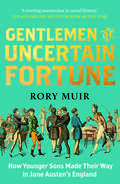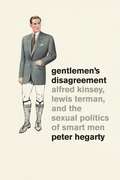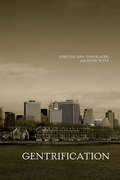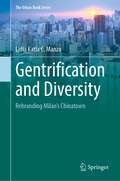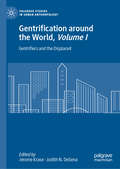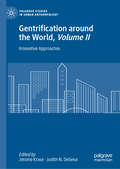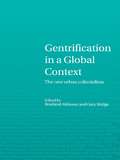- Table View
- List View
Gentlemen of Uncertain Fortune: How Younger Sons Made Their Way in Jane Austen's England
by Rory MuirA portrait of Jane Austen’s England told through the career paths of younger sons—men of good family but small fortune In Regency England the eldest son usually inherited almost everything while his younger brothers, left with little inheritance, had to make a crucial decision: What should they do to make an independent living? Rory Muir weaves together the stories of many obscure and well-known young men, shedding light on an overlooked aspect of Regency society. This is the first scholarly yet accessible exploration of the lifestyle and prospects of these younger sons.
Gentlemen's Disagreement: Alfred Kinsey, Lewis Terman, and the Sexual Politics of Smart Men
by Peter HegartyWhat is the relationship between intelligence and sex? In recent decades, studies of the controversial histories of both intelligence testing and of human sexuality in the United States have been increasingly common—and hotly debated. But rarely have the intersections of these histories been examined. In Gentlemen’s Disagreement, Peter Hegarty enters this historical debate by recalling the debate between Lewis Terman—the intellect who championed the testing of intelligence— and pioneering sex researcher Alfred Kinsey, and shows how intelligence and sexuality have interacted in American psychology. Through a fluent discussion of intellectually gifted onanists, unhappily married men, queer geniuses, lonely frontiersmen, religious ascetics, and the two scholars themselves, Hegarty traces the origins of Terman’s complaints about Kinsey’s work to show how the intelligence testing movement was much more concerned with sexuality than we might remember. And, drawing on Foucault, Hegarty reconciles these legendary figures by showing how intelligence and sexuality in early American psychology and sexology were intertwined then and remain so to this day.
Gentlemen's Disagreement: Alfred Kinsey, Lewis Terman, and the Sexual Politics of Smart Men
by Peter HegartyWhat is the relationship between intelligence and sex? In recent decades, studies of the controversial histories of both intelligence testing and of human sexuality in the United States have been increasingly common—and hotly debated. But rarely have the intersections of these histories been examined. In Gentlemen’s Disagreement, Peter Hegarty enters this historical debate by recalling the debate between Lewis Terman—the intellect who championed the testing of intelligence— and pioneering sex researcher Alfred Kinsey, and shows how intelligence and sexuality have interacted in American psychology. Through a fluent discussion of intellectually gifted onanists, unhappily married men, queer geniuses, lonely frontiersmen, religious ascetics, and the two scholars themselves, Hegarty traces the origins of Terman’s complaints about Kinsey’s work to show how the intelligence testing movement was much more concerned with sexuality than we might remember. And, drawing on Foucault, Hegarty reconciles these legendary figures by showing how intelligence and sexuality in early American psychology and sexology were intertwined then and remain so to this day.
Gentlemen's Disagreement: Alfred Kinsey, Lewis Terman, and the Sexual Politics of Smart Men
by Peter HegartyWhat is the relationship between intelligence and sex? In recent decades, studies of the controversial histories of both intelligence testing and of human sexuality in the United States have been increasingly common—and hotly debated. But rarely have the intersections of these histories been examined. In Gentlemen’s Disagreement, Peter Hegarty enters this historical debate by recalling the debate between Lewis Terman—the intellect who championed the testing of intelligence— and pioneering sex researcher Alfred Kinsey, and shows how intelligence and sexuality have interacted in American psychology. Through a fluent discussion of intellectually gifted onanists, unhappily married men, queer geniuses, lonely frontiersmen, religious ascetics, and the two scholars themselves, Hegarty traces the origins of Terman’s complaints about Kinsey’s work to show how the intelligence testing movement was much more concerned with sexuality than we might remember. And, drawing on Foucault, Hegarty reconciles these legendary figures by showing how intelligence and sexuality in early American psychology and sexology were intertwined then and remain so to this day.
Gentlemen's Disagreement: Alfred Kinsey, Lewis Terman, and the Sexual Politics of Smart Men
by Peter HegartyWhat is the relationship between intelligence and sex? In recent decades, studies of the controversial histories of both intelligence testing and of human sexuality in the United States have been increasingly common—and hotly debated. But rarely have the intersections of these histories been examined. In Gentlemen’s Disagreement, Peter Hegarty enters this historical debate by recalling the debate between Lewis Terman—the intellect who championed the testing of intelligence— and pioneering sex researcher Alfred Kinsey, and shows how intelligence and sexuality have interacted in American psychology. Through a fluent discussion of intellectually gifted onanists, unhappily married men, queer geniuses, lonely frontiersmen, religious ascetics, and the two scholars themselves, Hegarty traces the origins of Terman’s complaints about Kinsey’s work to show how the intelligence testing movement was much more concerned with sexuality than we might remember. And, drawing on Foucault, Hegarty reconciles these legendary figures by showing how intelligence and sexuality in early American psychology and sexology were intertwined then and remain so to this day.
Gentlemen's Disagreement: Alfred Kinsey, Lewis Terman, and the Sexual Politics of Smart Men
by Peter HegartyWhat is the relationship between intelligence and sex? In recent decades, studies of the controversial histories of both intelligence testing and of human sexuality in the United States have been increasingly common—and hotly debated. But rarely have the intersections of these histories been examined. In Gentlemen’s Disagreement, Peter Hegarty enters this historical debate by recalling the debate between Lewis Terman—the intellect who championed the testing of intelligence— and pioneering sex researcher Alfred Kinsey, and shows how intelligence and sexuality have interacted in American psychology. Through a fluent discussion of intellectually gifted onanists, unhappily married men, queer geniuses, lonely frontiersmen, religious ascetics, and the two scholars themselves, Hegarty traces the origins of Terman’s complaints about Kinsey’s work to show how the intelligence testing movement was much more concerned with sexuality than we might remember. And, drawing on Foucault, Hegarty reconciles these legendary figures by showing how intelligence and sexuality in early American psychology and sexology were intertwined then and remain so to this day.
Gentlemen's Disagreement: Alfred Kinsey, Lewis Terman, and the Sexual Politics of Smart Men
by Peter HegartyWhat is the relationship between intelligence and sex? In recent decades, studies of the controversial histories of both intelligence testing and of human sexuality in the United States have been increasingly common—and hotly debated. But rarely have the intersections of these histories been examined. In Gentlemen’s Disagreement, Peter Hegarty enters this historical debate by recalling the debate between Lewis Terman—the intellect who championed the testing of intelligence— and pioneering sex researcher Alfred Kinsey, and shows how intelligence and sexuality have interacted in American psychology. Through a fluent discussion of intellectually gifted onanists, unhappily married men, queer geniuses, lonely frontiersmen, religious ascetics, and the two scholars themselves, Hegarty traces the origins of Terman’s complaints about Kinsey’s work to show how the intelligence testing movement was much more concerned with sexuality than we might remember. And, drawing on Foucault, Hegarty reconciles these legendary figures by showing how intelligence and sexuality in early American psychology and sexology were intertwined then and remain so to this day.
Gentlemen's Gentlemen: From Boot Boys to Butlers, True Stories of Life Below Stairs
by Rosina HarrisonYou've read tales of lady's maids and cooks, housekeepers and nannies, but now it's time to hear from the other side of life as a servant. From the lamp boy to the butler, here are the fascinating storis from the men below stairs. This treasure-trove of memories, collected together by Rosina Harrison, bestselling author of The Lady's Maid, includes the night the ill-fated Edward VIII came to dinner; the time Charlie Chaplin scandalised the servants with his 'familiar' behaviour - and the occasion when a hot potato dropped down a lady's décolletage at a veryexclusive supper party . . .
Gentlemen's Prescriptions for Women's Lives: A Thousand Years of Biographies of Chinese Women
by Sherry J. MouAs far back as the first century BCE, Chinese dynastic historians - all men - began recording the achievements of Chinese women and creating a structure of understanding that would be used to limit and control them. To men, these women became role models for their daughters and wives; to the few literate women readers, they became paradigms for their own behavior. Thus, although these biographies are descriptive by nature, they actually became prescriptive. Gentlemen's Prescriptions for Women's Lives is an enlightening source for studying Chinese women of the Imperial era as well as for understanding Chinese womanhood in general. By contextualizing these biographies, the author shows us these women not just as the complaisant, calm-eyed, delicate figures that adorn Confucian texts, but also as the products of the Confucian tradition's appropriation of women.
Gentlemen's Prescriptions for Women's Lives: A Thousand Years of Biographies of Chinese Women
by Sherry J. MouAs far back as the first century BCE, Chinese dynastic historians - all men - began recording the achievements of Chinese women and creating a structure of understanding that would be used to limit and control them. To men, these women became role models for their daughters and wives; to the few literate women readers, they became paradigms for their own behavior. Thus, although these biographies are descriptive by nature, they actually became prescriptive. Gentlemen's Prescriptions for Women's Lives is an enlightening source for studying Chinese women of the Imperial era as well as for understanding Chinese womanhood in general. By contextualizing these biographies, the author shows us these women not just as the complaisant, calm-eyed, delicate figures that adorn Confucian texts, but also as the products of the Confucian tradition's appropriation of women.
Gentrification
by Loretta Lees Tom Slater Elvin WylyThis first textbook on the topic of gentrification is written for upper-level undergraduates in geography, sociology, and planning. The gentrification of urban areas has accelerated across the globe to become a central engine of urban development, and it is a topic that has attracted a great deal of interest in both academia and the popular press. Gentrification presents major theoretical ideas and concepts with case studies, and summaries of the ideas in the book as well as offering ideas for future research.
Gentrification
by Loretta Lees Tom Slater Elvin WylyThis first textbook on the topic of gentrification is written for upper-level undergraduates in geography, sociology, and planning. The gentrification of urban areas has accelerated across the globe to become a central engine of urban development, and it is a topic that has attracted a great deal of interest in both academia and the popular press. Gentrification presents major theoretical ideas and concepts with case studies, and summaries of the ideas in the book as well as offering ideas for future research.
Gentrification: A Working-class Perspective
by Kirsteen PatonFocusing on the working-class experience of gentrification, this book re-examines the enduring relationship between class and the urban. Class is so clearly articulated in the urban, from the housing crisis to the London Riots to the evocation of housing estates as the emblem of ’Broken Britain’. Gentrification is often presented to a moral and market antidote to such urban ills: deeply institutionalised as regeneration and targeted at areas which have suffered from disinvestment or are defined by ’lack’. Gentrification is no longer a peripheral neighbourhood process: it is policy; it is widespread; it is everyday. Yet comparative to this depth and breadth, we know little about what it is like to live with gentrification at the everyday level. Sociological studies have focused on lifestyles of the middle classes and the working-class experience is either omitted or they are assumed to be victims. Hitherto, this is all that has been offered. This book engages with these issues and reconnects class and the urban through an ethnographically detailed analysis of a neighbourhood undergoing gentrification which historicises class formation, critiques policy processes and offers a new sociological insight into gentrification from the perspective of working-class residents. This ethnography of everyday working-class neighbourhood life in the UK serves to challenge denigrated depictions which are used to justify the use of gentrification-based restructuring. By exploring the relationship between urban processes and working-class communities via gentrification, it reveals the ’hidden rewards’ as well as the ’hidden injuries’ of class in post-industrial neighbourhoods. In doing so, it provides a comprehensive ’sociology of gentrification’, revealing not only how gentrification leads to the displacement of the working class in physical terms but how it is actively used within urban policy to culturally displace the working-class subject and traditional
Gentrification and Displacement: The Forced Relocation of Public Housing Tenants in Inner-Sydney (SpringerBriefs in Sociology)
by Alan MorrisThis book examines the forced displacement of public housing residents in Sydney’s Millers Point and The Rocks communities. It considers the strategies deployed by the government to pressure tenants to move, and the social and personal impacts of the displacement on the residents themselves. Drawing on in-depth interviews with tenants alongside government and media communications, the Millers Point case study offers a penetrating and moving analysis of gentrification and displacement in one of Australia’s oldest and more unique working class and public housing neighbourhoods. Gentrification and Displacement advances work in urban studies by charting trends in urban renewal and displacement, furthering our understanding of public housing, gentrification and the effects of forced relocation on vulnerable urban communities.
Gentrification and Diversity: Rebranding Milan's Chinatown (The Urban Book Series)
by Lidia Katia ManzoThis book examines lived experiences of making, inhabiting and appropriating space, in relation to the upscale commercial gentrification of the Milan Chinatown. It inquires about the significance of diverse neighborhoods as emerging multicultural spaces? Are we talking about neighborhood entrepreneurs providing services and entertainment to create local urban culture, or are we talking about political/economic forces in the commodification of ethnic and cultural diversity? Starting from these questions, this book uses innovative visual ethnography and critical urban research to understand the relationship between community-based entrepreneurs, local politics, residents’ sense of belonging, and patterns of city branding strategies in Milan, the fashion capital of Italy.This book is intended for researchers and students in the fields of sociology, anthropology, urban studies, geography, and urban planning. Additionally, it is appropriate for practitioners in the fields of urban planning, housing policies, and community development.
Gentrification and Resistance: Researching Displacement Processes and Adaption Strategies
by Ilse HelbrechtGentrification is arguably the most dynamic area of conflict in current urban development policy – it is the process by which poorer populations are displaced by more affluent groups. Although gentrification is well-documented, German and international research largely focuses on improvements in the built environment and social composition of neighbourhoods. The consequences for those who are displaced often remain overlooked. Where do they move? What does it mean to be forced to leave a familiar residential area? What kinds of resistance strategies are developed? How does anti-gentrification work? With a focus on Berlin – the German "capital of gentrification" – the chapters in this volume use innovative methods to explore these pressing questions.
Gentrification and Schools: The Process of Integration When Whites Reverse Flight (Education Policy)
by J. StillmanThrough fifty-two interviews with New York City parents in gentrifying neighborhoods, this book examines the school choice process to determine how, through the compounding effect of these parents' many individual choices, a segregated urban school in a gentrifying neighborhood is able to transform into an integrated school.
Gentrification around the World, Volume I: Gentrifiers and the Displaced (Palgrave Studies in Urban Anthropology)
by Jerome Krase Judith N. DeSenaBringing together scholarly but readable essays on the process of gentrification, this two-volume collection addresses the broad question: In what ways does gentrification affect cities, neighborhoods, and the everyday experiences of ordinary people? In this first volume of Gentrification around the World, contributors from various academic disciplines provide individual case studies on gentrification and displacement from around the globe: chapters cover the United States of America, Spain, Brazil, Sweden, Japan, Korea, Morocco, Great Britain, Canada, France, Finland, Peru, India, Indonesia, Pakistan, Syria, and Iceland. The qualitative methodologies used in each chapter—which emphasize ethnographic, participatory, and visual approaches that interrogate the representation of gentrification in the arts, film, and other mass media—are themselves a unique and pioneering way of studying gentrification and its consequences worldwide.
Gentrification around the World, Volume II: Innovative Approaches (Palgrave Studies in Urban Anthropology)
by Jerome Krase Judith N. DeSenaBringing together scholarly but readable essays on the process of gentrification, this two-volume collection addresses the broad question: In what ways does gentrification affect cities, neighborhoods, and the everyday experiences of ordinary people? In this second volume of Gentrification around the World, contributors contemplate different ways of thinking about gentrification and displacement in the abstract and “on-the-ground.” Chapters examine, among other topics, social class, development, im/migration, housing, race relations, political economy, power dynamics, inequality, displacement, social segregation, homogenization, urban policy, planning, and design. The qualitative methodologies used in each chapter—which emphasize ethnographic, participatory, and visual approaches that interrogate the representation of gentrification in the arts, film, and other mass media—are themselves a unique and pioneering way of studying gentrification and its consequences worldwide.
Gentrification as a Global Strategy: Neil Smith and Beyond (Routledge Critical Studies in Urbanism and the City)
by Abel Albet Núria BenachThis book pays homage to Neil Smith’s ideas, offering a critical approach and rich collection of insights that draw on Smith’s work for inspiration and debate. With interdisciplinary and international contributions from leading experts, the book demonstrates the impact of Smith’s ideas on understanding the role of urbanisation in general and gentrification, in particular, in contemporary society. The book demonstrates how gentrification varies significantly from city to city, across different cultural and political-economic regimes, and in terms of the timing of urban transformations. This collection provides a forum for debate for those working in urban regeneration and citizenship, and those directly affected by the processes and problems arising from gentrification. It will be of interest to students and scholars in urban geography, urban sociology, cultural studies, and wider social and urban theories.
Gentrification as a Global Strategy: Neil Smith and Beyond (Routledge Critical Studies in Urbanism and the City)
by Abel Albet Núria BenachThis book pays homage to Neil Smith’s ideas, offering a critical approach and rich collection of insights that draw on Smith’s work for inspiration and debate. With interdisciplinary and international contributions from leading experts, the book demonstrates the impact of Smith’s ideas on understanding the role of urbanisation in general and gentrification, in particular, in contemporary society. The book demonstrates how gentrification varies significantly from city to city, across different cultural and political-economic regimes, and in terms of the timing of urban transformations. This collection provides a forum for debate for those working in urban regeneration and citizenship, and those directly affected by the processes and problems arising from gentrification. It will be of interest to students and scholars in urban geography, urban sociology, cultural studies, and wider social and urban theories.
Gentrification in a Global Context: The New Urban Colonialism (Housing and Society Series)
by Rowland Atkinson Gary BridgeGentrification, a process of class neighbourhood upgrading, is being identified in a broader range of urban contexts throughout the world. This book throws new light and evidence to bear on a subject that deeply divides commentators on its worth and social costs given its ability to physically improve areas but also to displace indigenous inhabitants.Gentrification in a Global Perspective brings together the most recent theoretical and empirical research on gentrification at a global scale. Each author gives an overview of gentrification in their country so that each chapter retains a unique approach but tackles a common theme within a shared framework. The main feature of the book is a critical and well-written set of chapters on a process that is currently undergoing a resurgence of interest and one that shows no sign of abating.
Gentrification in a Global Context (Housing and Society Series)
by Rowland Atkinson Gary BridgeGentrification, a process of class neighbourhood upgrading, is being identified in a broader range of urban contexts throughout the world. This book throws new light and evidence to bear on a subject that deeply divides commentators on its worth and social costs given its ability to physically improve areas but also to displace indigenous inhabitants.Gentrification in a Global Perspective brings together the most recent theoretical and empirical research on gentrification at a global scale. Each author gives an overview of gentrification in their country so that each chapter retains a unique approach but tackles a common theme within a shared framework. The main feature of the book is a critical and well-written set of chapters on a process that is currently undergoing a resurgence of interest and one that shows no sign of abating.
Gentrification in Chinese Cities: State Institutions, Space and Society (Urban Sustainability)
by Qinran YangThis book provides an institutional interpretation of state-facilitated gentrification in Chengdu, an emerging central city of China. It generalizes the three aspects of institutional changes in the cultural, economic and social spheres that have thus far directed the operation of gentrification in the transitional economy: the creative destruction of consumption spaces, the spatial production of excess, and the unequal redistribution of spatial resources to low-income residents. The interactions of state and society, are examined in navigating the institutional changes and forming the Chinese distinctions of gentrification. The author argues that these three aspects of institutional changes characterize gentrification in Chengdu as a transformative force of development led by the state and capitalists and championed by middle-class consumers. This gentrification mode periodically catalyzes new spaces and collective cultures, which then necessitate the stimulation of new consumption behaviors and the formation of new consumer classes, at the expense of the spatial demands for the even larger number of low-income residents. However, in the context of China's unique state–society relations, some low-income groups may also ride the wave of social transformation. The author suggests that this type of gentrification integrates into not the essence of uneven geographical development in a capitalist society, but China’s unique model of urbanization and development, which is often state-driven, innovative and even involuted so as to sustain continuous growth. Though the research is focused on urban China, this book also contributes to methodological issues on gentrification research on a global scale. It is skeptical both of the structural explanation and of the revelation of unsorted differences; instead, it aims to generate midrange regularities of gentrification in Chinese cities. Institutional change is treated as an intermediary that, on the one hand, responds to the global trends and, on the other hand, adapts to local preconditions. Mixed methods, including statistical and spatial analysis, institutional analysis, and an extensive ethnographic study, are used to investigate gentrification from a structural perspective, a historical perspective, and as a grounded process within the locality.
